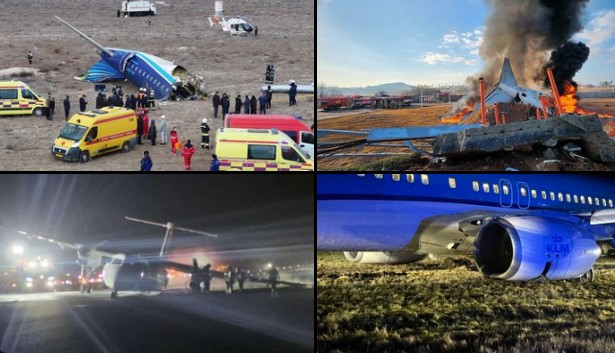Recent Aviation Incidents: A Closer Look at Jeju Air, Air Canada, KLM, and Azerbaijan Airlines Flights
The aviation world recently witnessed multiple incidents, highlighting the importance of safety and preparedness. Here’s a detailed look at the key events involving Jeju Air Flight 2216, Air Canada Express Flight 2259, KLM Flight 1204, and Azerbaijan Airlines Flight 8243.
Jeju Air Flight 2216: Tragedy in South Korea
On December 29, 2024, Jeju Air Flight 2216, a Boeing 737-800 arriving from Bangkok, faced a catastrophic crash at Muan International Airport, South Korea. The aircraft reportedly failed to deploy its landing gear due to a suspected bird strike, resulting in a devastating crash landing. Out of the 181 passengers and crew onboard, 179 tragically lost their lives.
This incident is one of the deadliest in South Korea’s aviation history, prompting an investigation to identify the exact causes and prevent future tragedies.
Air Canada Express Flight 2259: A Narrow Escape
On the same day, Air Canada Express Flight 2259, a de Havilland Dash 8-400, experienced a dramatic landing gear failure while arriving at Halifax Stanfield International Airport, Nova Scotia. The aircraft skidded along the runway, and one wing caught fire upon impact.
Remarkably, all 73 passengers and crew were safely evacuated, with no injuries reported. This incident underlines the effectiveness of emergency protocols and the professionalism of the flight crew.
KLM Flight 1204: Emergency Landing in Norway
KLM Flight 1204, a Boeing 737-800 en route from Oslo to Amsterdam, encountered hydraulic system failure shortly after takeoff on December 29, 2024. The flight was diverted to Sandefjord Torp Airport, where the aircraft veered off the runway during an emergency landing.
Despite the severity of the situation, all 176 passengers and six crew members were unharmed. The quick decision-making by the pilots and ground crew played a pivotal role in avoiding injuries.
Azerbaijan Airlines Flight 8243: An Ongoing Investigation
Details about Azerbaijan Airlines Flight 8243 remain scarce, but reports indicate that the flight experienced an incident requiring an investigation. While the specifics have not been disclosed, aviation authorities are likely working to understand and address the event.
Lessons from These Incidents
These events serve as stark reminders of the challenges faced by the aviation industry. While some incidents, like those involving Air Canada and KLM, ended without loss of life, others, such as Jeju Air Flight 2216, underscore the tragic consequences when safety measures fail.
Aviation authorities worldwide are conducting thorough investigations to determine the causes and implement improved safety protocols. Pilots, crew members, and engineers continue to prioritize passenger safety, making air travel one of the safest modes of transportation despite these incidents.
Key Takeaways for the Aviation Community
- Improved Bird Strike Prevention: Enhanced radar systems and habitat control around airports could reduce the risk of bird strikes, a suspected cause in the Jeju Air crash.
- Landing Gear Maintenance: Regular checks and fail-safes for landing gear can prevent mechanical failures.
- Emergency Training: The Air Canada and KLM incidents highlight the importance of crew training and quick decision-making in emergencies.
- Enhanced Monitoring Systems: Early detection of hydraulic or mechanical failures can save lives, as seen in KLM’s case.
The Final Words
While aviation incidents are rare, they are profound reminders of the complexity and responsibility involved in air travel. These recent cases emphasize the need for continued vigilance, technological advancements, and adherence to strict safety standards to prevent such tragedies in the future.
Airlines and regulatory bodies worldwide are learning from these events to make flying even safer for all.
Also Explore more about The Aesthetic Life


